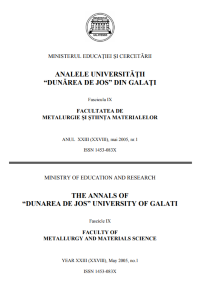Nanostructured SiC-Ni Composite Coatings Obtained By Electrodeposition – A Tribocorrosion Study
Abstract
The tribocorrosion properties of SiC (20 nm) - Ni nanostructured coatings have been studied in pin on disc tribocorrosimeter connected with an electrochemical cell. The objectives of our study in principal is to fully understanding the tribocorrosion process kinetic and mechanism of modified surfaces by co-depositing nano silicon carbide particles with nickel. The samples with coating on a top of a cylinder were installed in a cell, containing the electrolyte and electrodes, and mounted on a pin-on-disc tribometer, with the working surface of the specimen facing upwards. The counterbody (pin) was a corrundum cylinder (7 mm in diameter), mounted vertically on a rotating head, above the specimen. The lower spherical end (radius = 100 mm) of the pin, was then applied against the composite surface (disc) with an adjustable normal force. When rotation was applied, the end of the pin draws a circular wear track (16 mm in diameter) on the working composite surface. Continuous friction tests were carried out. Different friction forces were applied during 10000 tours with a rotation speed of counterbody from 30 to 120 tours/min. Some features of these tests reproduce the wear conditions of composite coatings in real conditions. K2SO4 0.5 M was used as corrosive and passivating electrolyte for tribocorrosion tests.
Downloads
References
[2]. L. BENEA, P. L. BONORA, A. BORELLO, S. MARTELLI, F. WENGER , P. PONTHIAUX, J. GALLAND; J. Electrochem. Soc.., 148 (7) C461-C465 (2001).
[3]. BENEA L., BONORA P.L., BORELLO A., MARTELLI S.; Materials and Corrosion, 53, 23-29 (2002).
[4]. L. Benea, P. L. Bonora, F. WENGER, P. PONTHIAUX, J. GALLAND; "Processing and Properties of Electrodeposited Composite Coatings: Results and Perspectives", KEY NOTE Lecture, CD-ROM Proceeding: 15TH International Corrosion Congress -Frontiers in Corrosion Science and Technology, Granada, Spania, 22-27 Septembrie 2002.
[5]. L. Benea, Composite Electrodeposition -Theory and Practice, Ed: PORTO FRANCO, Romania, ISBN 973 557 490 X, (1998).
[6] S. W. Watson; J. Electrochem Soc., 140, 2235 (1993).
[7]. G. Maurin and A. Lavanant; J. Appl. Electrochem., 25, 1113-1121 (1995).
[8]. J. Fransaer, J. P. Celis and J.R.Roos; J. Electrochem. Soc., 139, 413-425 (1992).
[9]. J. Fransaer, J. P. Celis and J. R. Roos; Metal Finishing, 91, 97-100 (1993).
[10]. L. Benea and G. Carac, Metallurgy and New Materials Researches V No 2, 1-19(1997).
[11]. K. H. Hou, M.D. Ger, L.M. Wang, S.T. Ke, Wear 253 [(2002) 994-1003.
[12]. R. Oltra, in "Wear-Corrosion Interactions in Liquid Media" edited by A. A. Sagües and E. I. Meletis, Minerals, Metals and Materials Soc. (1991) 3.
[13]. Garcia, D. Drees and J.P. Celis, Wear, 249, p.452-460 (2001).
[14]. L. Benea, P. Ponthiaux, F. Wenger, J. Galland, D. Hertz, J. Y. Malo; Wear, Special Issue Wear Modelling,256 (2004) Issues 9-10, p. 948-953.
[15]. L. BENEA, P. L. BONORA, A. BORELLO, S. MARTELLI; Wear, 249, Issue 10-11, Nov-2001, p. 995-1003.



